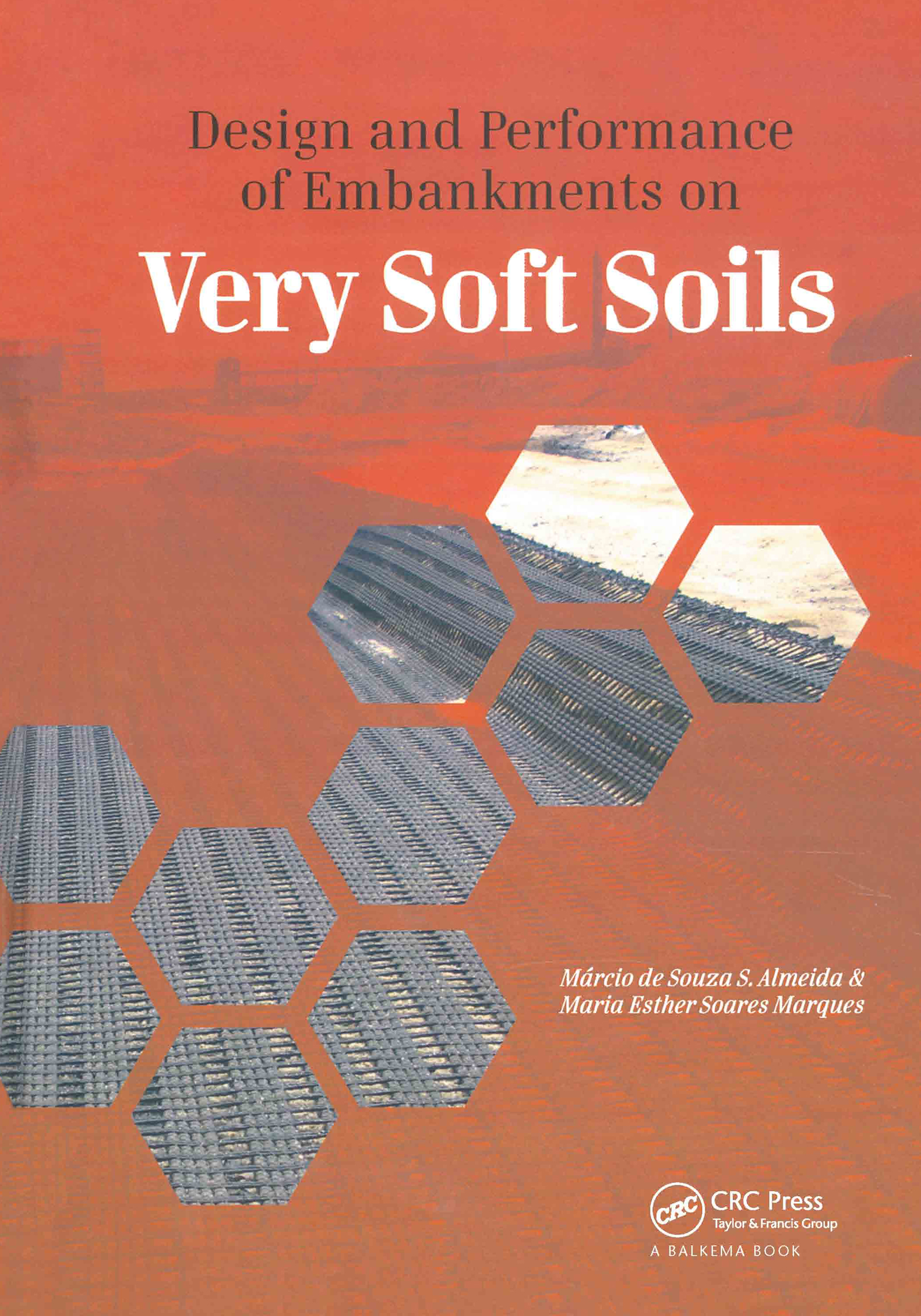
DESIGN AND PERFORMANCE OF EMBANKMENT ON VERY SOFT SOILS
Marcio de Souza S. Almeida, Maria Esther Soares Marques
Embankment construction projects on very soft soil often give rise to serious problems. This volume on geotechnics and soft soil engineering therefore treats all phases of the design and construction process exhaustively, from the first investigation step to the monitoring of constructed work. The book presents the development concepts necessary for the project stages and discusses in great detail construction methods, displacement estimations, stability analyses, monitoring, and various other aspects involved. Extensive attention is furthermore paid to the application of geosynthetics as a tool to improve the stability of soft soils and embankments. Including various tables and practical data for many geographical areas in the world, this reference volume is essential reading for engineers and researchers in geotechnical engineering, construction, and related disciplines.
Contents
1 Construction methods of embankments on soft soils
1.1 Replacement of soft soils and displacement fills
1.1.1 Replacement of soft soils
1.1.2 Displacement fills
1.2 Conventional embankment with temporary surcharge
1.3 Embankments built in stages, embankments with lateral berms and reinforced embankments
1.4 Embankment on vertical drains
1.5 Lightweight fills
1.6 Embankments on pile-like elements
1.7 Construction methodologies for harbor works
1.8 Final remarks
2 Site investigation
2.1 Preliminary investigations
2.1.1 Borings
2.1.2 Characterization
2.2 Complementary investigations
2.2.1 In situ tests
2.2.2 Laboratory tests
2.3 Vane tests
2.3.1 Equipment and procedures
2.3.2 Undrained strength
2.3.3 Clay sensitivity
2.3.4 Stress history
2.3.5 Clay anisotropy
2.3.6 Test correction
2.4 Piezocone test
2.4.1 Equipment and procedures
2.4.2 Correction of cone resistance
2.4.3 Preliminary soil classification
2.4.4 Undrained strength (Su)
2.4.5 Stress history
2.4.6 Coefficient of consolidation
2.5 T-bar test
2.6 Soil sampling for laboratory tests
2.7 Oedometer consolidation tests
2.7.1 Other consolidation tests
2.7.2 Sample quality
2.8 Triaxial tests
2.9 Final remarks
3 Geotechnical properties of very soft soils: Rio de Janeiro soft clays
3.1 Overall behavior of very soft soils: Cam clay models
3.1.1 Stress and strain variables
3.1.2 Model parameters
3.1.3 Yield conditions
3.2 Index properties of some Rio de Janeiro clays
3.3 Compressibility and stress history
3.3.1 Compressibility
3.3.2 Overconsolidation ratio (OCR)
3.4 Hydraulic conductivity and coefficient of consolidation
3.5 Soil strength
3.5.1 Undrained strength – laboratory and in situ data
3.5.2 Effective strength parameters
3.6 Deformation data
3.7 Viscous behavior
3.7.1 Strain rate during shearing
3.7.2 Strain rate during constant loading oedometer tests
3.8 Field studies
3.8.1 Embankment I
3.8.2 Embankment II
4 Prediction of settlements and horizontal displacements
4.1 Types of settlements
4.1.1 Immediate settlement
4.1.2 Primary consolidation settlements
4.1.3 Secondary compression settlement
4.2 Staged embankment settlements
4.3 Prediction of horizontal displacements
4.4 Final remarks
5 Acceleration of settlements: use of vertical drains and surcharge
5.1 Embankments on vertical drains
5.2 Vertical drains
5.2.1 Theoretical solutions
5.2.2 Consolidation with purely radial drainage
5.2.3 Diameter of influence and equivalent diameter of PVDs
5.2.4 Consolidation with combined radial and vertical drainage
5.2.5 Influence of smear in PVD performance
5.2.6 Influence of mandrel size on soil disturbance
5.2.7 Parameters for consideration of disturbance (smear)
5.2.8 The effect of well resistance
5.2.9 Specification of PVD
5.2.10 Sequence for radial drainage calculations
5.3 Design of the horizontal drainage blanket
5.4 Use of temporary surcharge
5.4.1 Use of surcharge with and without vertical drains
5.4.2 Vacuum preloading
5.4.3 Use of surcharge to minimize secondary compression settlements
5.5 Final remarks
6 Stability of unreinforced and reinforced embankments
6.1 Design parameters
6.1.1 Undrained strength of clay
6.1.2 Embankment strength
6.1.3 Geosynthetic reinforcement parameters
6.2 Failure modes of embankments on soft soils
6.3 Foundation failure: Critical height of embankment
6.4 Global stability analysis of unreinforced embankments
6.4.1 Circular failure surfaces
6.4.2 Non-circular failure surfaces
6.5 Reinforced embankments
6.5.1 Effects of reinforcement
6.5.2 Foundation failure
6.5.3 Failure due to lateral sliding of embankment
6.5.4 Global failure
6.5.5 Definition of tensile force in reinforcement
6.6 Stability analysis of stage constructed embankments
6.6.1 Conceptual aspects
6.6.2 Undrained strength of the clay for staged construction
6.6.3 Illustration of stability analysis of staged construction
6.6.4 Considerations on the stability analysis for staged constructed embankments
6.7 Sequence for stability analysis of embankments on soft soils
6.7.1 Unreinforced embankments
6.7.2 Reinforced embankments
6.7.3 Reinforced embankment built in stages
6.8 Final remarks
7 Embankments on pile-like elements
7.1 Piled embankments with geosynthetic platform
7.1.1 The working platform settlement and overall embankment behavior
7.1.2 Arching effect on soils
7.1.3 Defining the geometry of piled embankments
7.1.4 Calculation of vertical stresses acting on the geosynthetic
7.1.5 Calculation of tensile force acting on the reinforcement
7.1.6 Case histories of piled embankments
7.2 Embankments on traditional granular columns
7.2.1 Traditional granular columns using the vibro-replacement method
7.2.2 Design and analysis principles
7.2.3 Settlement reduction factor (soil improvement factor)
7.2.4 Settlement computations
7.2.5 Stability analysis
7.2.6 General behavior of embankments on granular columns
7.3 Encased granular columns
7.3.1 General description
7.3.2 Execution methods
7.3.3 Calculation methods
7.3.4 Case histories for applications of embankments over encased granular columns
7.4 Final remarks
8 Monitoring embankments on soft soils
8.1 Monitoring vertical displacements
8.1.1 Settlement plates
8.1.2 Depth extensometers
8.1.3 Settlement Profiler
8.2 Measurement of horizontal displacements
8.3 Measurements of pore pressures
8.4 Monitoring of the tensile forces in geosynthetic reinforcements
8.5 Interpretation of monitoring results
8.5.1 Asaoka’s method (1978)
8.5.2 Pore pressure analysis
8.5.3 Discussion on obtaining cv and ch from monitoring data
8.5.4 Stability of embankment by horizontal displacements analysis
8.5.5 In situ compression curves
8.6 New trends in geotechnical instrumentation
8.7 Final remarks
References
Annex
Subject index
Observaciones 2013
17x24
Paginas 228
Precio 125,00
PUEDE EFECTUAR YA SU PEDIDO SI LO DESEA EN WWW.INGENIERIAYARTE.COM
